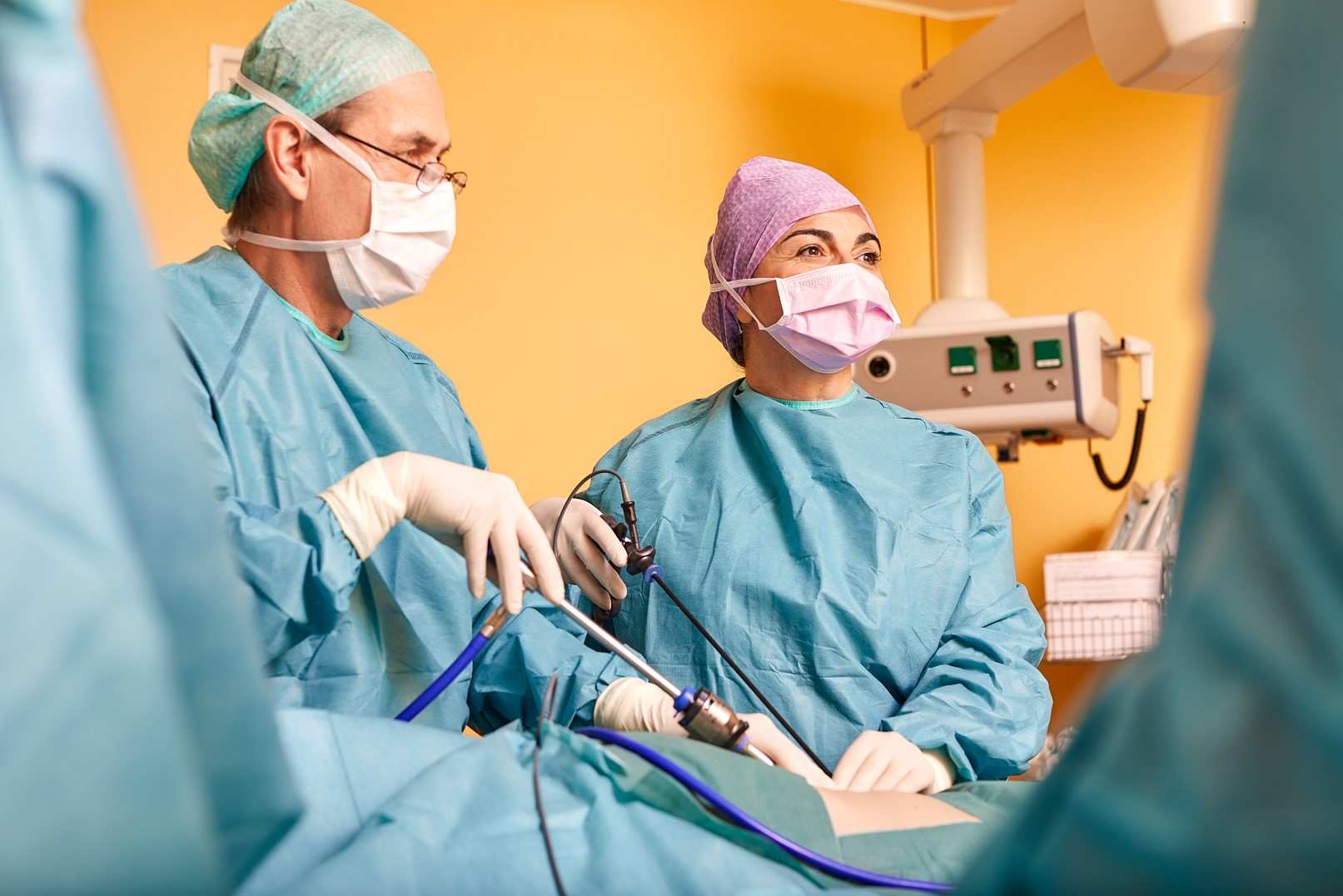Why is the MILOS surgery from Hamburg considered the gold standard for abdominal hernias worldwide? How does the procedure combine the advantages of common minimally invasive and open surgical procedures? What are the advantages of MILOS for patients?

Your MILOS Center in Hamburg
MILOS for abdominal wall hernia: surgical technique from Hamburg
With these questions you are right in the Hamburg Hernia Center, because: The gentle MILOS surgery for abdominal wall hernias such as Umbilical hernias and Incisional hernias as well as diastases recti was developed by our head physician Dr. Reinpold and his team in Hamburg-Wilhelmsburg – and subsequently established internationally within a few years.
Consequently, all specialists in our hernia center have special expertise and experience with the MILOS technique for abdominal wall hernia surgery. In total, our team of physicians has performed more than 6,000 hernia surgeries using the sophisticated MILOS technique – with excellent results and extremely low complication and recurrence rates.
As a preliminary point: Note on the terms used:
MILOS stands for MInior Less Open Sublay Operation. A variant of MILOS surgery is the EMILOS procedure (endoscopic MInior Less Open Sublay Surgery). In this case, endoscopy is performed after the space between the peritoneum and the abdominal wall is filled with CO2 gas. In MILOS surgery, endoscopy is performed without gas.
Both variants of abdominal hernia surgery are equally gentle for patients and are frequently used at the Hamburg Hernia Center. For the sake of readability, we will focus on the term MILOS in the following, but principally include EMILOS.
MILOS: The principle of gentle abdominal wall hernia surgery
To better understand the principle of MILOS surgery and the advantages of abdominal wall hernia surgery “made in Hamburg”, you should know:
An abdominal wall hernia – such as an umbilical or incisional hernia – can only be cured by surgery. To prevent a repeated hernia, hernias are usually closed with a resilient synthetic mesh. Suture closure is advisable only in rare exceptional cases, such as when the abdominal wall hernia is very small and the defect measures less than 1.5 cm.
MILOS combines the advantages of minimally invasive and open surgical procedures
Before the development of MILOS surgery, patients and surgeons had the choice between open and minimally invasive surgical methods – and had to weigh the respective advantages and disadvantages individually.
Thus, the indispensable synthetic mesh was inserted either with a large incision outside the abdominal cavity (open sublay operation) or minimally invasively into the abdominal cavity (laparoscopic IPOM procedure).
In contrast, the MILOS operation, as the first abdominal wall hernia operation worldwide, makes it possible to insert the synthetic mesh minimally invasively and outside the abdominal cavity – in the most favorable layer between the peritoneum and the supporting abdominal wall. In this way, MILOS combines the advantages of the common processes, avoiding respective disadvantages.
GDPR: This video will only load after a click
Dr. Reinpold as a guest on NDR Visite on the subject of MILOS
(only available in German)
MILOS surgery for abdominal wall hernia: Advantages
- small, gentle skin incisions
- mesh implantation outside the delicate abdominal cavity
- no need to fasten the mesh with staples or sutures; accordingly, no risk of painful nerve damage
- hernia gaps (holes in the abdominal wall) are closed over the accurately positioned mesh in an anatomically correct manner
- very good restoration of the abdominal wall function
- very good cosmetic result
- highly significant reduction in acute and chronic pain compared to all established surgical procedures
- significantly fewer complications such as organ injuries, bleeding, inflammation or repeated hernias
MILOS surgery: Advantages scientifically confirmed
Not only the doctors and patients of the Hamburg Hernia Center could convince themselves of the excellent results after MILOS surgery. Already in 2018, the first broad-based Herniamed registry study with over 600 scar hernias confirmed our very good experience with the MILOS procedure for abdominal wall hernia surgery.
The study, published in the internationally renowned surgical journal Annals of Surgery showed significantly fewer complications, chronic pain and recurring hernias compared to conventional surgical procedures. (Read the full study here).
In the meantime, we can look back on a wealth of experience of more than 6,000 abdominal wall hernia operations according to the MILOS procedure in our hernia center in Hamburg. These clearly underline the very good results already demonstrated in 2018.
As part of the Herniamed quality assurance study, we contact our patients again after one, five and ten years in each case to obtain information about the long-term outcome of abdominal wall hernia surgery. With respect to MILOS surgery, current so-called 5-year “follow-ups” also show extremely low pain and recurrence fracture rates of less than 2 percent each.

Dr. Reinpold and Dr. Berger developed the MILOS surgical procedure and established it internationally.
MILOS: For whom is the gentle abdominal wall hernia surgery suitable?
After numerous TV and press reports (among others by the NDR) many patients with abdominal wall hernia or rectus diastasis ask us specifically about the MILOS operation. We can fulfill this wish in most cases, as the procedure is suitable for very many types and degrees of hernias. However, as with any surgical procedure, there are exceptions with regard to MILOS surgery: For example, very large abdominal wall hernias and incisional hernias larger than 15cm often cannot be operated on using the minimally invasive MILOS technique. In these cases, larger skin incisions are usually required. Nevertheless, we also apply the principles of MILOS surgery to these giant hernias at the Hamburg Hernia Center. Thus, even in cases of very large hernias, we make the smallest possible skin incision and insert the synthetic mesh outside the abdominal cavity.
For more details on the treatment of very large abdominal wall hernias and the special services offered at the Hamburg Hernia Center, please read our information on the Incisional hernia and IFT.
In contrast, very small abdominal wall hernias with a defect size of less than 1.5 cm often do not require a synthetic mesh. Here, a suture closure is the method of choice.
As a general rule: a detailed examination and precise diagnosis of your hernia is always required to plan the best abdominal wall hernia surgery for you. Moreover, in our consultations we always ask you about any concomitant diseases that may preclude general anesthesia and thus minimally invasive abdominal wall hernia surgery such as MILOS.